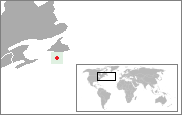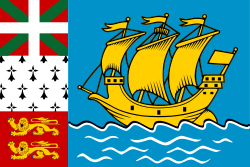

The following outline is provided as an overview of and topical guide to Saint Pierre and Miquelon:
Contents
- General reference
- Geography of Saint Pierre and Miquelon
- Environment of Saint Pierre and Miquelon
- Regions of Saint Pierre and Miquelon
- Demography of Saint Pierre and Miquelon
- Neighbours of Saint Pierre and Miquelon
- Government and politics of Saint Pierre and Miquelon
- Branches of the government of Saint Pierre and Miquelon
- Foreign relations of Saint Pierre and Miquelon
- Law and order in Saint Pierre and Miquelon
- Military of Saint Pierre and Miquelon
- Local government in Saint Pierre and Miquelon
- History of Saint Pierre and Miquelon
- Culture of Saint Pierre and Miquelon
- Art in Saint Pierre and Miquelon
- Sport in Saint Pierre and Miquelon
- Economy and infrastructure of Saint Pierre and Miquelon
- Education in Saint Pierre and Miquelon
- See also
- References
- External links
The Territorial Collectivity of Saint Pierre and Miquelon (French : Collectivité territoriale de Saint-Pierre-et-Miquelon) is an overseas collectivity of France located in the North Atlantic Ocean about 30 kilometres (19 mi) south of the Canadian Island of Newfoundland. [1] The collectivity comprises a group of small islands, the main ones being Saint Pierre and Miquelon.
The islands are part of France and the European Union but due to special immigration procedures, EU nationals who are not French citizens are not allowed to exercise free movement and business establishment in the archipelago. [2] [ failed verification ]
The archipelago is the only remnant of the former colonial territory of New France that remains under French control.




